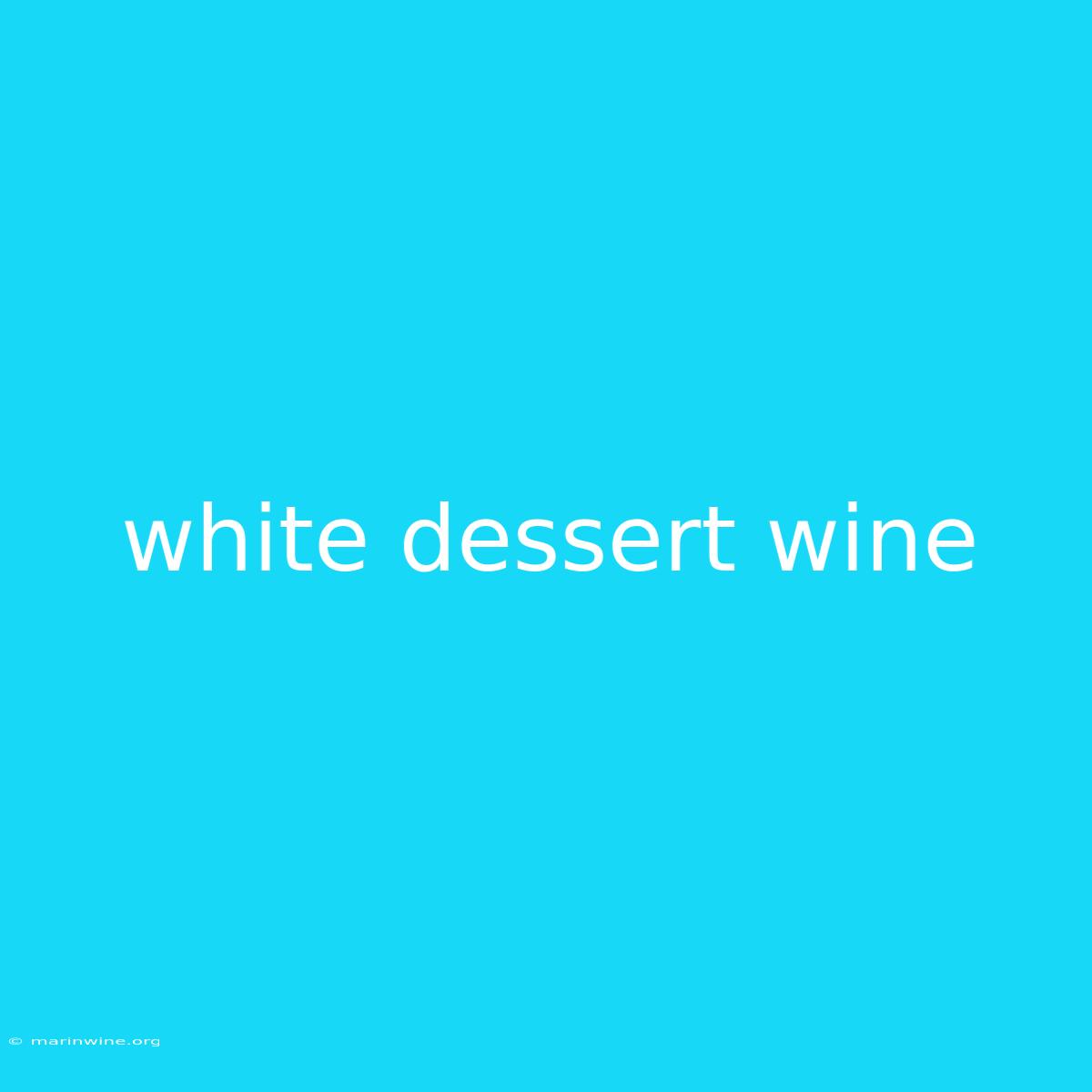Unmasking the Sweet Delights: A Dive into the World of White Dessert Wines
Have you ever wondered what makes a dessert wine so special? It's not just the sweetness; it's the intricate dance of flavors, textures, and aromas that makes these wines truly captivating. White dessert wines are a symphony of sweetness, acidity, and complexity, offering an exciting world of indulgence waiting to be explored.
Why It Matters: Understanding white dessert wines opens a door to a world of culinary pairings and unique drinking experiences. From the classic sweetness of Moscato to the rich complexity of Sauternes, these wines offer a diverse range of flavors and styles, catering to both seasoned wine enthusiasts and curious newcomers.
Key Takeaways of White Dessert Wines:
| Key Takeaway | Description |
|---|---|
| Sweetness | A defining characteristic, ranging from delicately sweet to intensely syrupy. |
| Acidity | Balances the sweetness, providing freshness and complexity. |
| Flavor Profiles | Vary widely, encompassing fruity notes, floral aromas, and hints of spice and honey. |
| Production Methods | Often involve techniques like botrytis cinerea (noble rot) or late harvest, which concentrate sugars and flavors. |
| Pairing Potential | A versatile companion for desserts, cheeses, and even spicy dishes. |
White Dessert Wines: A Deeper Dive
White Dessert Wines: A Delicate Balance of Sweetness and Acidity
White dessert wines are often characterized by their high sugar content, resulting from various techniques employed during the winemaking process. These techniques focus on concentrating the grapes' natural sugars, leading to a rich and sweet profile. However, the sweetness is balanced by a vibrant acidity, which is crucial for achieving a harmonious taste. This acidity provides freshness and complexity, preventing the wine from becoming overly cloying and enhancing its overall flavor profile.
Exploring the Spectrum of White Dessert Wines
The world of white dessert wines boasts a remarkable diversity of flavors, each reflecting the unique characteristics of its origin and production methods. Here's a glimpse into some popular categories:
1. Moscato: Known for its light, refreshing sweetness and delicate aromas of floral and citrus notes, Moscato is a popular choice for casual gatherings and dessert pairings.
2. Sauternes: This renowned French wine is produced using the noble rot technique, where the grapes are affected by a specific mold that concentrates their sugars and creates a complex, honeyed, and apricot-like flavor profile.
3. Riesling: While Riesling is often associated with dry wines, it also produces some exceptional dessert wines. These Rieslings are known for their vibrant acidity and a wide range of flavor profiles, from delicate sweetness to intense fruitiness.
4. Gewürztraminer: Characterized by its distinctive aroma of lychee, roses, and spice, Gewürztraminer dessert wines offer a unique combination of sweetness and aromatic complexity.
5. Ice Wine: Produced by harvesting grapes that have frozen on the vine, ice wines are renowned for their intense sweetness and complex flavors.
White Dessert Wines: A Culinary Journey
White dessert wines are not limited to dessert pairings; their versatility extends beyond the realm of sweetness. Their balanced sweetness and acidity make them ideal companions for a range of culinary creations.
1. Pairing with Desserts: The classic pairing of white dessert wines with desserts is a testament to their sweet harmony. These wines complement the richness of cakes, pies, tarts, and other sweet treats.
2. Accompanying Cheeses: The interplay of sweetness and acidity in white dessert wines beautifully complements the savory notes of cheeses. They pair well with soft cheeses like brie and camembert, as well as blue cheeses like Roquefort.
3. Exploring Spicy Dishes: Don't be afraid to step outside the box! The sweetness of white dessert wines can balance the heat of spicy dishes, creating a surprising and delicious contrast.
FAQ for White Dessert Wines
Q: Can I drink white dessert wine on its own?
A: Absolutely! Many enjoy the sweetness and complexity of these wines as a standalone beverage.
Q: What temperature should I serve white dessert wine?
A: Serve chilled, between 45-50°F (7-10°C) for optimal enjoyment.
Q: How long can I keep a bottle of white dessert wine?
A: Most white dessert wines have a shelf life of 5-10 years, with some even aging for longer periods.
Q: How can I tell if a white dessert wine is spoiled?
A: Look for signs of oxidation, such as a browning of the wine or a vinegar-like smell.
Tips for Choosing and Enjoying White Dessert Wines
1. Start with a Light-Bodied Wine: For those new to dessert wines, opt for lighter-bodied styles like Moscato or a young Riesling.
2. Experiment with Flavors: Don't be afraid to explore different styles. Each white dessert wine offers a unique flavor profile, so tasting is key to finding your personal favorites.
3. Pair with Complementary Flavors: Consider the flavors of the dessert or dish when selecting a white dessert wine. Look for flavors that complement or contrast with the food.
4. Serve in a Small Glass: Using smaller glasses helps to concentrate the aromas and flavors of the wine.
5. Sip and Savor: Allow yourself to savor each sip, appreciating the nuances of sweetness, acidity, and complex aromas.
Summary of White Dessert Wines
White dessert wines are a delightful category of wines offering a sweet escape from everyday routine. From the delicate floral notes of Moscato to the rich, honeyed complexity of Sauternes, these wines provide a captivating journey through a spectrum of flavors and textures. By understanding the key characteristics and production techniques, you can embark on a thrilling exploration of the world of white dessert wines, expanding your palate and unlocking a new realm of culinary enjoyment.
Closing Message: As you delve into the world of white dessert wines, remember to embrace experimentation and discover your personal favorites. These sweet delights offer a unique opportunity to explore the intricacies of flavor and indulge in the art of wine appreciation.

